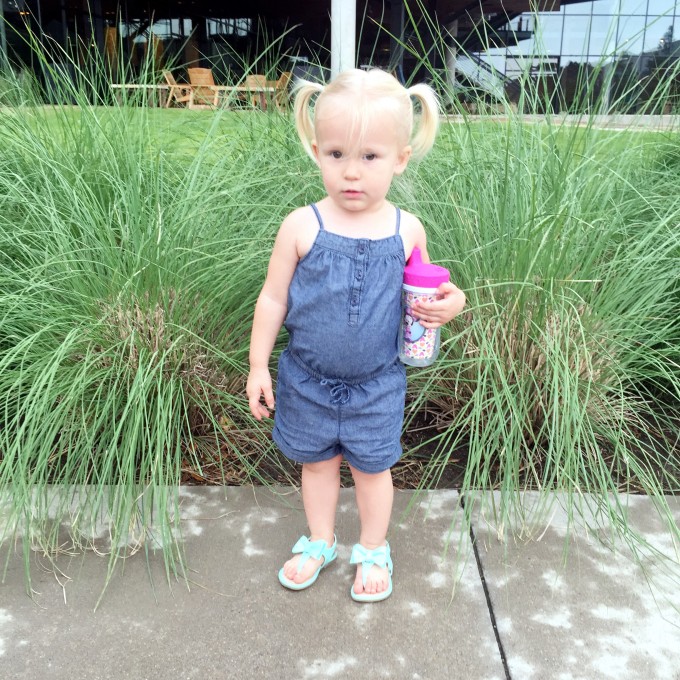gap romper (similar for baby and little girl) | target sandals
I normally don’t write this much, so forgive this minor diversion from “normal,” but I thought several of you out there would benefit today’s post.
As a speech therapist and mother to a toddler, I am often asked by those around me if their child is behind developmentally in regards to language. My response is always the same – I outline the general language milestones (I’ve listed them below), and then remind them that their child is still really young and that comparison is the thief of all joy. As a mom, I totally get how easy it is to fall into the trap of comparing your child to other kids – comparing the amount of words they have, the clothes they wear, the activities they’re enrolled in, etc. I am guilty of doing this from time to time, but don’t do it mommies! Remember that each child is so very different from the next (thank goodness, right?) and each of your own kids will be different from each other. Some kids are outgoing, some are shy, some will have a large vocabulary by 24 months, some won’t, and it’s okay. There are so many factors that go into language development that it’s almost impossible to compare kids.
So what’s my advice as a speech therapist and a mom? Relax. Yes, be informed – there is no harm in that, but relax and enjoy your little one.
The second question I’m often asked by parents is: “What can I do to help foster language development?” To which I say, talk to your child all the time. Tell them everything. I know there are points in the day where you are so tired that you just want to go through the motions – get them changed, fed and in bed, but don’t miss out on all the opportunities you have to model good language. It’s as simple as this example of talking through a diaper change:
“Okay, Emma Grace, it’s time to change your diaper. Let’s put you on the changing table and take off your clothes. Now I’m going to take off your dirty diaper. Oh look, no poo poo this time, it’s just potty! Okay, let’s get a wipe and clean you off. Here’s your new diaper. Do you see big bird on your diaper. He’s a yellow bird. Okay, your diapers back on, let’s pull up your shorts. Alright, we’re all finished! Time to play!”
And just like that, in a 3 minute mundane activity, you’ve just modeled 60+ words for your kiddo!
All this to say, I have included the speech and language developmental milestones via the ASHA website for you below. ASHA stands for American Speech-Language-Hearing Association and is a great resource for you! If you have any questions or concerns please, please do not hesitate to email me (hello@fleurdille.com). Happy Tiny Tuesday!!!
Signs of a Language Disorder
- Doesn’t smile or interact with others (birth–3 months)
- Doesn’t babble (4–7 months)
- Makes few sounds (7–12 months)
- Does not use gestures (e.g., waving, pointing) (7–12 months)
- Doesn’t understand what others say (7 months–2 years)
- Says only a few words (12–18 months)
- Doesn’t put words together to make sentences (1½–3 years)
- Has trouble playing and talking with other children (2–3 years)
- Has problems with early reading and writing skills—for example, may not show an interest in books or drawing (2½–3 years)
Ways to Help With Language Disorders
- Listen and respond to your child
- Talk, read, and play with your child
- Communicate with your child in the language that you are most comfortable using
- Know that it’s good to teach your child to speak a second language
- Talk about what you are doing and what your child is doing
- Use a lot of different words with your child
- Use longer sentences as your child gets older
- Have your child play with other children
Signs of a Speech Sound Disorder
- Says p, b, m, h, and w incorrectly in words (1–2 years)
- Says k, g, f, t, d, and n incorrectly in words (2–3 years)
- Produces speech that is unclear, even to familiar people (2–3 years)
Ways to Help With Speech Sound Disorders
- Say the sounds correctly when you talk—it’s okay if your child makes some mistakes with sounds
- Don’t correct speech sounds—it’s more important to let your child keep talking
Signs of Stuttering (Disfluency)
- Struggles to say sounds or words (2½–3 years)
- Repeats first sounds of words—”b-b-b-ball” for “ball” (2½–3 years)
- Pauses a lot while talking (2½–3 years)
- Stretches sounds out—”f-f-f-f-farm” for “farm” (2½–3 years)
Ways to Help With Stuttering or Disfluency
- Give your child time to talk
- Do not interrupt or stop your child while he or she is speaking
- See an SLP if you are concerned (Many young children stutter for a short period of time; in most cases, the stuttering will stop.)
xo – anna




